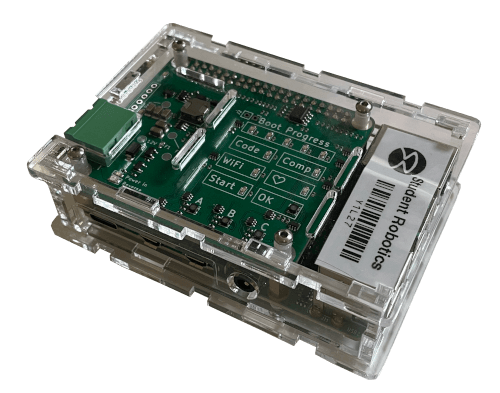Raspberry Pi
Do not re-flash or edit the SD card. This will stop your robot working!

The brain of your robot is a Raspberry Pi 3B+. This handles the running of your python code, recognition of markers and sends control commands to the other boards.
Power HAT
Your Raspberry Pi has a 'KCH' Power HAT mounted on the top. This allows you to connect power to it using a 7.5mm terminal block.
Indicator LEDs
There are 18 indicator LEDs on the Pi Power Hat, that can grouped into 3 categories:
- Power status
- Software status
- User LEDs
Power Status
These are the 4 LEDs on the left side of the board. They show the status of the power supply to the Raspberry Pi.
| LED | Meaning |
|---|---|
| 5V Power | The Brain Board is powered |
| Reg Power | 5V regulator is functioning |
| 12V Power | 12V power is being provided to the Power Hat |
| Reverse Polarity | The 12V power is reversed |
Software Status
These are the 11 LEDs in the top right of the board, each with a prominent label. These LEDs show the status of the software running on the Raspberry Pi. This includes both the software that runs your code, and the overall robot operating system.
| LED | Meaning |
|---|---|
| Boot Progress | Progress Bar for Brain Boot Progress |
| Code | A USB containing code is plugged in |
| Comp | The Robot is in Competition Mode |
| WiFi | The Robot has connected to WiFi and the kit UI is available |
| ♥ (Heartbeat) | Blinks when the Brain is running |
| Start | The Robot is waiting to start |
| OK | Shows the code status, see below table |
The key LED to look out for is the OK LED, which shows the status of your code.
| OK LED Colour | Meaning |
|---|---|
| Off | No code available |
| Blue | Your code is running |
| Magenta | Your code has been killed |
| Green | Your code has finished without errors |
| Red | Your code has crashed |
The LEDs may take a few seconds to update after you insert or remove your USB.
Technical Details
Your robot is running a customised version of the Raspberry Pi OS operating system.
When a USB stick is inserted, the software will look for a file named robot.py, and then execute it.
The output of your code is written to a file named log.txt on the USB stick.
